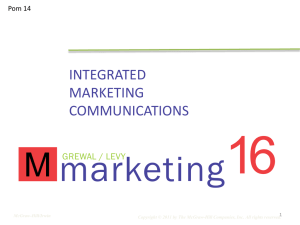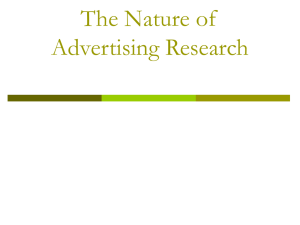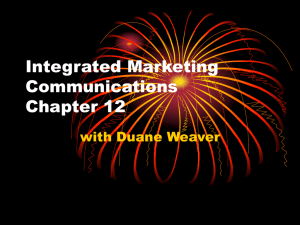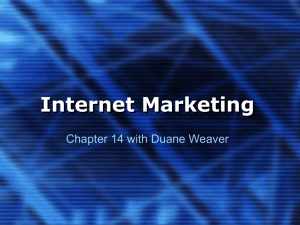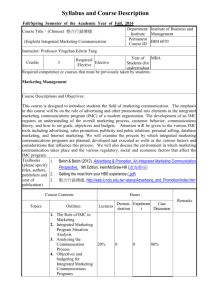BA230 week1-2 Concepts
advertisement
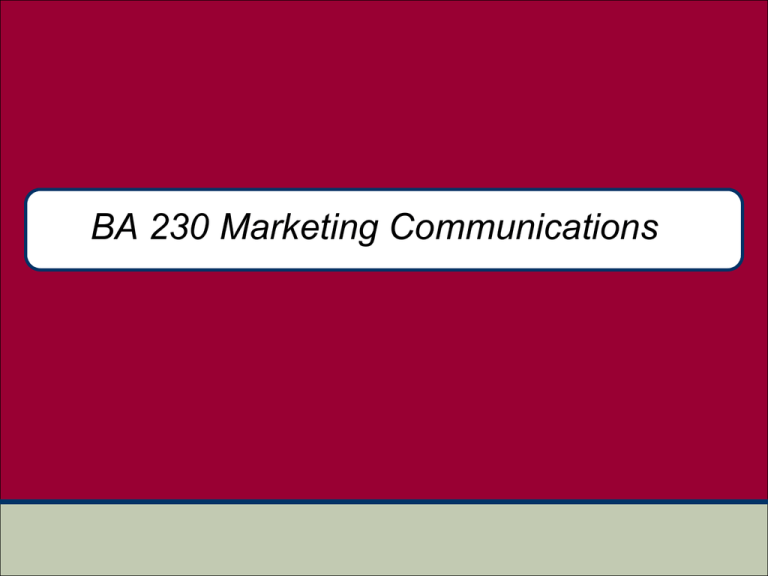
BA 230 Marketing Communications What is Marketing? • Marketing the sum of all the activities involved in the planning, pricing, promoting, distributing and selling of goods and services to satisfy consumer’s needs and wants. • Marketing is the process that connects suppliers with end users What is Marketing? • An organizational function and a set of processes for creating, communicating, and delivering value to customers and for managing customer relationships in ways that benefit the organization and its stakeholders. Our task is to focus Direct Marketing Product Advertising Word of Mouth Place Marketing Mix Public Relations Social Media Price Events Promotion Guerilla Sales Promotion Personal Selling Mobile Two Types of Marketing Efforts B2B B2C Communication Process How Brand Communication Works Corporate Communications Marketing Communications • Focus on multiple stakeholders • Focus on customers • Multiple channels • Defined set of channels • Variety of communication • Controlled communication types • Positions an entire organization • Positions a product or service • Less room for creativity • More room for creativity • Needs to be consistent with corporate identity and corporate brand attributes • Needs to be consistent with product and brand attributes What is Marketing Communications? • Creating, delivering, managing, and valuating brand messages which are the information and experiences that impact how a brand is perceived. • Marketing communications is any communication that flow from an organisation to its customers, potential customers and other groups who may influence its success. – – – – Informs Persuades Differentiates Reminds What is Integrated Marketing Communication? IMC is designed to make all aspects of marketing communication such as advertising, sales promotion, public relations, and direct marketing work together as a unified force, rather than permitting each to work in isolation. IMC, as a philosophical concept, dictates that all parties involved in the firm’s communication efforts co-ordinate to speak to target audience(s) with • one voice, • a unified message and • a consistent image What is Integrated Marketing Communication? Early definitions of IMC: • a concept of marketing communications planning that recognizes the added value of a comprehensive plan that evaluates the strategic roles of a variety of communications disciplines (for example, general advertising, direct response, sales promotion, and public relations) and • combines these disciplines to provide clarity, consistency, and maximum communications impact. (Schultz, 1993, p. 10) What is Integrated Marketing Communication? • IMC is the process of developing and implementing various forms of persuasive communications programs with customers and prospects over time. • The goal of IMC is to influence or directly affect the behaviour of the selected communications audience. IMC considers all sources of brand or company contacts which a customer or prospect has with the product or service as potential delivery channels for future messages. • In sum, the IMC process starts with the customer or prospect and then works back to determine and define the forms and methods through which persuasive communications programs should be developed. (Schultz, 1993a, p. 17) What is Integrated Marketing Communication? • • • • Tactical coordination of marcom elements Redefining the scope of marcom Application of information techolology Financial and strategic integration Stages in IMC Development (Source: Schultz and Kitchen, 2000b) What is IMC? “A process that entails the planning, creation, integration and implementation of diverse forms of marketing promotion.” All marketing communications should be: (1) clearly positioned, (2) directed to a particular target market, (3) created to achieve a specific objective, (4) undertaken to accomplish the objective within budget constraint. The Focus of IMC • • • • Traditional Transactions Consumers One-to-many Product driven • • • • Integrated Relationships Stakeholders One-to-few Customer driven Important Names for IMC • • • • Don Schultz George E.Belch, Michael A. Belch Tom Duncan Philip J. Kitchen Changes in Marketing Communication Practices Changes in the consumer market: • • • • • • Information overload, advertising overload, media fragmentation, media choices, smaller audiences, increasing number of “me-too” products, • complexity and change in FMCG markets, • increasing media interest in social behaviour of companies, • increase reliance on highly targeted communication methods., • increased efforts to assess communications’ return on investment. Changes in the supplier market: • • • • • Multiple acquisitions and structural changes, focus on short-term results, interest in strategic importance of communication, interest in internal communication, heightened demands on suppliers Why Is Integration So Important? Integration When brand messages are integrated… = …they reinforce each other… Synergy … and create a synergy effect like: 2 + 2 = 5 “2 + 2 = 5” Statement • • • Not True…Interaction Results Depend on Interaction of the two (or more) variables Example: – – • $10 Billboard = $20 Sales $10 TV Ad = $30 Sales But… – $20 TV/Billboard = $60 Sales IMC Mix Advertising Personal Selling Sales Promotion/POP Public Relations Direct Marketing Social Media Word of Mouth Mobile Media Guerilla Events Benefits of IMC • CLARITY - Avoid giving conflicting messages • CONSISTENCY - All messages convey the core values/attributes of corporate identity and brand • SYNERGY - Messages reinforce each other through repetition and development Contemporary IMC Approach IMC is like an orchestra Musical score guides all the members of the orchestra to play together IMC plan guides all the members of an organization to work together At the end of the course we can say IMC is like But not like this.... • Cadbury promised consumers free sporting goods if they will save and submit special wrappers from Cadbury products. • The campaign was supported with advertising, sponsorship, sales promotion, package design, and marketing public relations. • However, there is a distinct unease in the minds of customers, consumers, and industry experts on the links between chocolate and obesity, and between chocolate and sporting prowess. • Integration is both a way to develop campaigns that maximize consistency among all the marcom tools and a philosophy that monitors and manages all brand messages with all stakeholders at all contact points.


